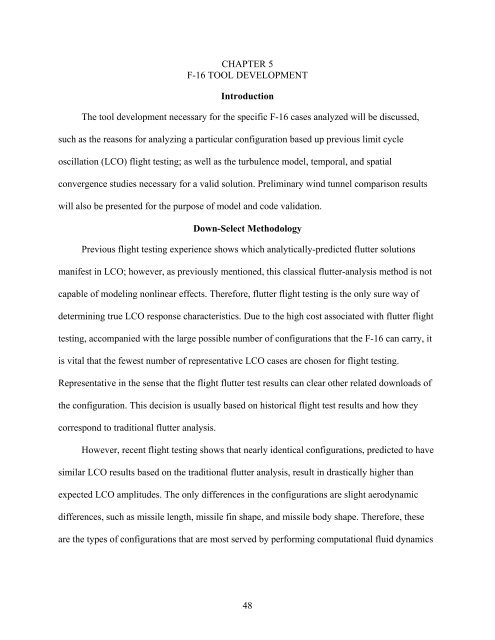university of florida thesis or dissertation formatting template
university of florida thesis or dissertation formatting template
university of florida thesis or dissertation formatting template
Create successful ePaper yourself
Turn your PDF publications into a flip-book with our unique Google optimized e-Paper software.
CHAPTER 5<br />
F-16 TOOL DEVELOPMENT<br />
Introduction<br />
The tool development necessary f<strong>or</strong> the specific F-16 cases analyzed will be discussed,<br />
such as the reasons f<strong>or</strong> analyzing a particular configuration based up previous limit cycle<br />
oscillation (LCO) flight testing; as well as the turbulence model, temp<strong>or</strong>al, and spatial<br />
convergence studies necessary f<strong>or</strong> a valid solution. Preliminary wind tunnel comparison results<br />
will also be presented f<strong>or</strong> the purpose <strong>of</strong> model and code validation.<br />
Down-Select Methodology<br />
Previous flight testing experience shows which analytically-predicted flutter solutions<br />
manifest in LCO; however, as previously mentioned, this classical flutter-analysis method is not<br />
capable <strong>of</strong> modeling nonlinear effects. Theref<strong>or</strong>e, flutter flight testing is the only sure way <strong>of</strong><br />
determining true LCO response characteristics. Due to the high cost associated with flutter flight<br />
testing, accompanied with the large possible number <strong>of</strong> configurations that the F-16 can carry, it<br />
is vital that the fewest number <strong>of</strong> representative LCO cases are chosen f<strong>or</strong> flight testing.<br />
Representative in the sense that the flight flutter test results can clear other related downloads <strong>of</strong><br />
the configuration. This decision is usually based on hist<strong>or</strong>ical flight test results and how they<br />
c<strong>or</strong>respond to traditional flutter analysis.<br />
However, recent flight testing shows that nearly identical configurations, predicted to have<br />
similar LCO results based on the traditional flutter analysis, result in drastically higher than<br />
expected LCO amplitudes. The only differences in the configurations are slight aerodynamic<br />
differences, such as missile length, missile fin shape, and missile body shape. Theref<strong>or</strong>e, these<br />
are the types <strong>of</strong> configurations that are most served by perf<strong>or</strong>ming computational fluid dynamics<br />
48
















